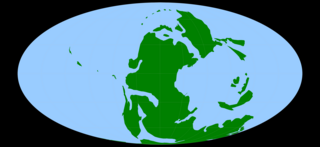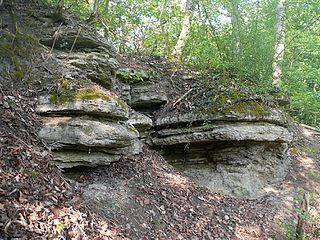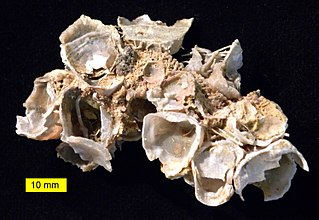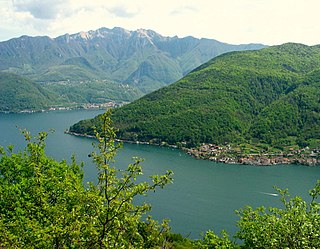
The Permian is a geologic period and stratigraphic system which spans 47 million years from the end of the Carboniferous Period 298.9 million years ago (Mya), to the beginning of the Triassic Period 251.902 Mya. It is the last period of the Paleozoic Era; the following Triassic Period belongs to the Mesozoic Era. The concept of the Permian was introduced in 1841 by geologist Sir Roderick Murchison, who named it after the region of Perm in Russia.
The Guadalupian is the second and middle series/epoch of the Permian. The Guadalupian was preceded by the Cisuralian and followed by the Lopingian. It is named after the Guadalupe Mountains of New Mexico and Texas, and dates between 272.95 ± 0.5 – 259.1 ± 0.4 Mya. The series saw the rise of the therapsids, a minor extinction event called Olson's Extinction and a significant mass extinction called the end-Capitanian extinction event. The Guadalupian was previously known as the Middle Permian.

The Cisuralian is the first series/epoch of the Permian. The Cisuralian was preceded by the Pennsylvanian and followed by the Guadalupian. The Cisuralian Epoch is named after the western slopes of the Ural Mountains in Russia and Kazakhstan and dates between 298.9 ± 0.15 – 272.3 ± 0.5 Ma.
The Furongian is the fourth and final epoch and series of the Cambrian. It lasted from 497 to 485.4 million years ago. It succeeds the Miaolingian series of the Cambrian and precedes the Lower Ordovician Tremadocian Stage. It is subdivided into three stages: the Paibian, Jiangshanian and the unnamed 10th stage of the Cambrian.

In the geologic timescale, the Anisian is the lower stage or earliest age of the Middle Triassic series or epoch and lasted from 247.2 million years ago until 242 million years ago. The Anisian Age succeeds the Olenekian Age and precedes the Ladinian Age.
In the geologic timescale, the Capitanian is an age or stage of the Permian. It is also the uppermost or latest of three subdivisions of the Guadalupian Epoch or Series. The Capitanian lasted between 264.28 and 259.51 million years ago. It was preceded by the Wordian and followed by the Wuchiapingian.

The Carnian is the lowermost stage of the Upper Triassic Series. It lasted from 237 to 227 million years ago (Ma). The Carnian is preceded by the Ladinian and is followed by the Norian. Its boundaries are not characterized by major extinctions or biotic turnovers, but a climatic event occurred during the Carnian and seems to be associated with important extinctions or biotic radiations. Another extinction occurred at the Carnian-Norian boundary, ending the Carnian age.

In the geologic timescale, the Roadian is an age or stage of the Permian. It is the earliest or lower of three subdivisions of the Guadalupian Epoch or Series. The Roadian lasted between 273.01 and 266.9 million years ago (Ma). It was preceded by the Kungurian and followed by the Wordian.
In the geologic timescale, the Wordian is an age or stage of the Permian. It is the middle of three subdivisions of the Guadalupian Epoch or Series. The Wordian lasted between 266.9 and 264.28 million years ago (Ma). It was preceded by the Roadian and followed by the Capitanian.

In the geologic timescale, the Wuchiapingian or Wujiapingian is an age or stage of the Permian. It is also the lower or earlier of two subdivisions of the Lopingian Epoch or Series. The Wuchiapingian spans the time between 259.51 and 254.14 million years ago (Ma). It was preceded by the Capitanian and followed by the Changhsingian.

In the geologic time scale, the Changhsingian or Changxingian is the latest age or uppermost stage of the Permian. It is also the upper or latest of two subdivisions of the Lopingian Epoch or Series. The Changhsingian lasted from 254.14 to 251.9 Ma ago. It is preceded by the Wuchiapingian age/stage and is followed by the Induan age/stage.

In the geologic timescale, the Middle Triassic is the second of three epochs of the Triassic period or the middle of three series in which the Triassic system is divided in chronostratigraphy. The Middle Triassic spans the time between 247.2 Ma and 237 Ma. It is preceded by the Early Triassic Epoch and followed by the Late Triassic Epoch. The Middle Triassic is divided into the Anisian and Ladinian ages or stages.

The Induan is the first age of the Early Triassic epoch in the geologic timescale, or the lowest stage of the Lower Triassic series in chronostratigraphy. It spans the time between 251.9 Ma and 251.2 Ma. The Induan is sometimes divided into the Griesbachian and the Dienerian subages or substages. The Induan is preceded by the Changhsingian and is followed by the Olenekian.

The Ladinian is a stage and age in the Middle Triassic series or epoch. It spans the time between 242 Ma and ~237 Ma. The Ladinian was preceded by the Anisian and succeeded by the Carnian.
The Famennian is the later of two faunal stages in the Late Devonian epoch. The most recent estimate for its duration is that it lasted from around 371.1 to 359.3 million years ago. An earlier 2012 estimate, still used by the International Commission on Stratigraphy, is that it lasted from 372.2 million years ago to 358.9 million years ago. It was preceded by the Frasnian stage and followed by the Tournaisian stage.
In the geological timescale, the Llandovery Epoch occurred at the beginning of the Silurian Period. The Llandoverian Epoch follows the massive Ordovician-Silurian extinction events, which led to a large decrease in biodiversity and an opening up of ecosystems.

Permocupedidae is a family of Protocoleopteran stem group beetles. They first appeared during the Early Permian, and were one of the dominant groups of beetles during the Middle Permian. They became rare in the Late Permian, with only one species known from the Triassic, Frankencupes ultimus from the Middle Triassic (Anisian) Röt Formation of Germany. They are thought to have been xylophagous, which is presumed to be the ancestral ecology of beetles.
Conodonts are an extinct class of animals whose feeding apparatuses called teeth or elements are common microfossils found in strata dating from the Stage 10 of the Furongian, the fourth and final series of the Cambrian, to the Rhaetian stage of the Late Triassic. These elements can be used alternatively to or in correlation with other types of fossils in the subfield of the stratigraphy named biostratigraphy.

The Capitanian mass extinction event, also known as the end-Guadalupian extinction event, the Guadalupian-Lopingian boundary mass extinction, the pre-Lopingian crisis, or the Middle Permian extinction, was an extinction event that predated the end-Permian extinction event. The mass extinction occurred during a period of decreased species richness and increased extinction rates near the end of the Middle Permian, also known as the Guadalupian epoch. It is often called the end-Guadalupian extinction event because of its initial recognition between the Guadalupian and Lopingian series; however, more refined stratigraphic study suggests that extinction peaks in many taxonomic groups occurred within the Guadalupian, in the latter half of the Capitanian age. The extinction event has been argued to have begun around 262 million years ago with the Late Guadalupian crisis, though its most intense pulse occurred 259 million years ago in what is known as the Guadalupian-Lopingian boundary event.
Taoheodon is an extinct genus of dicynodont therapsid from the Sunjiagou Formation in the Shanxi province of China, dated to the Wuchiapingian age of the Late Permian. Its type and only known species is T. baizhijuni. Taoheodon was a close relative of the well known Dicynodon, and may represent a biogeographical link between the South African Dicynodon and similar dicynodonts found in Laos.















